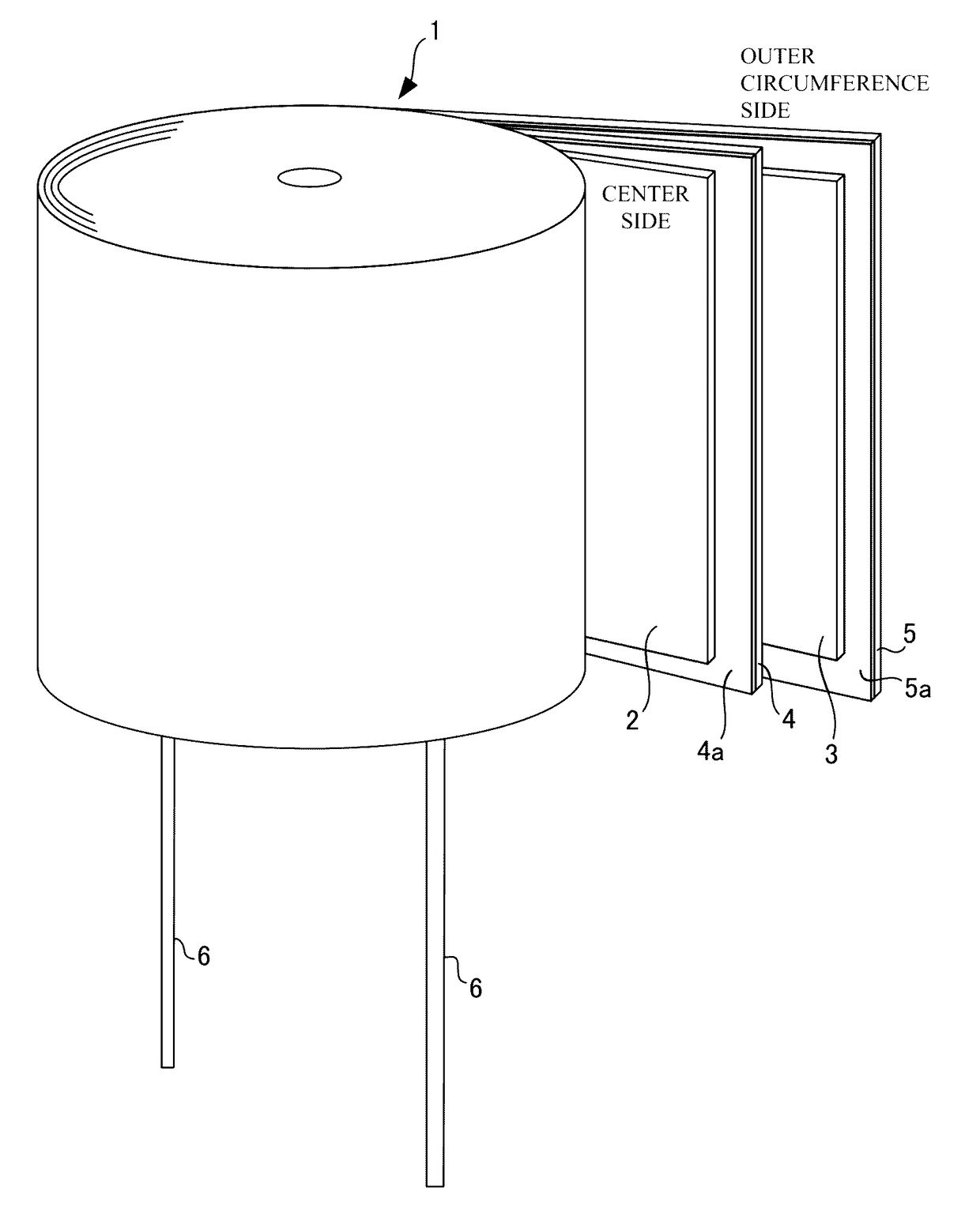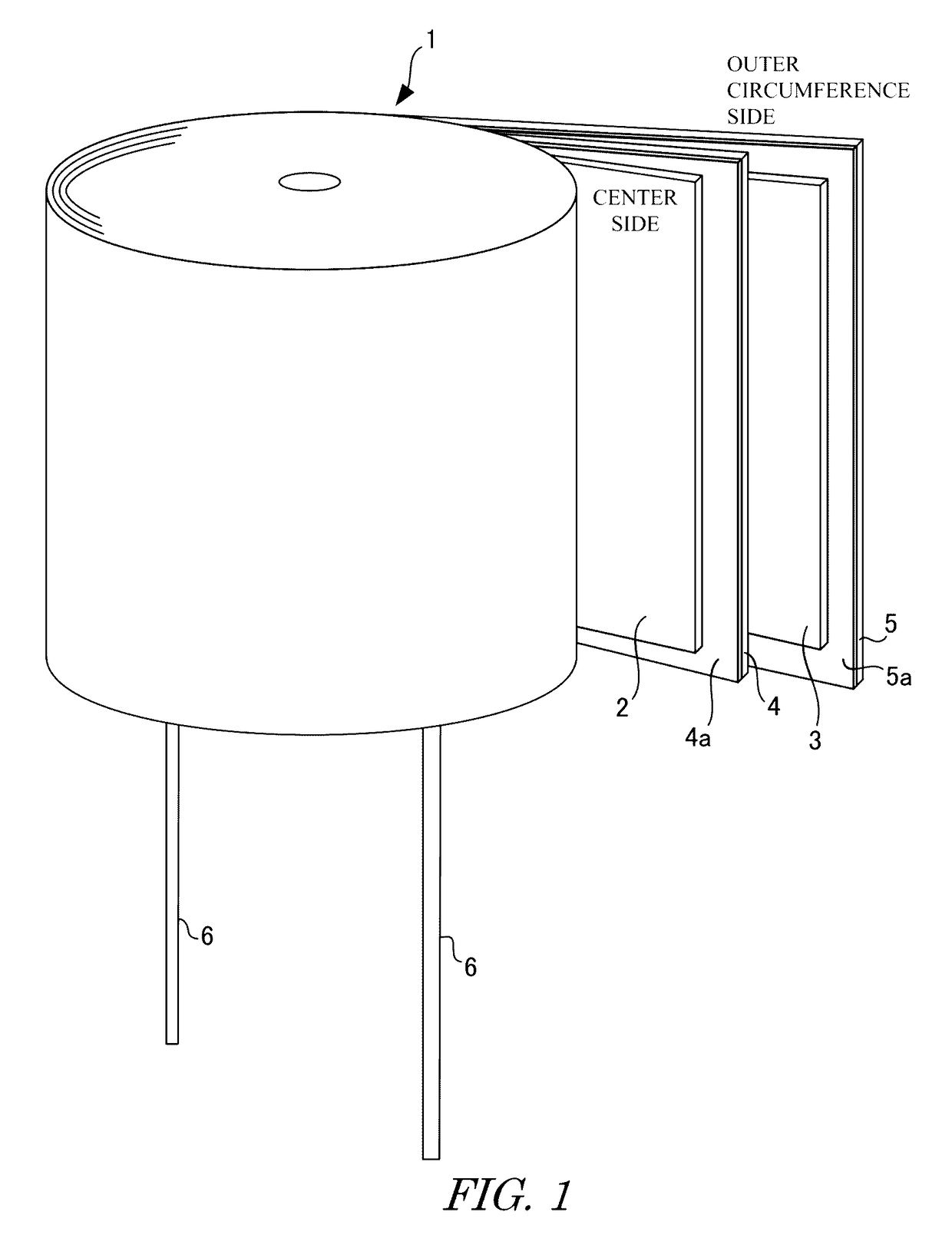Capacitor and method of manufacturing capacitor
- Summary
- Abstract
- Description
- Claims
- Application Information
AI Technical Summary
Benefits of technology
Problems solved by technology
Method used
Image
Examples
first embodiment
[0037](Structure)
[0038]A structure of an electrolytic capacitor according to a first embodiment will be explained in detail with reference to FIGS. 1 and 2. The electrolytic capacitor is manufactured by impregnating a capacitor element 1 illustrated in FIG. 1 with an electrolyte solution, placing the capacitor element 1 into an outer casing, sealing the outer casing by a seal body, and finally performing a chemical re-conversion process.
[0039]As illustrated in FIG. 1, this capacitor element 1 is manufactured by connecting lead terminals 6, 6 to an anode foil 2 and a cathode foil 3 respectively, laminating the anode foil 2 and the cathode foil 3 with each other via a separator 4 and a separator 5 therebetween, and winding this laminated sheet.
[0040]A method for winding this laminated sheet is not limited to any particular scheme, but it is desirable that the cathode foil 3 to disposed at the outer circumference side in view of the improvement of a heat dissipation performance. For ex...
second embodiment
[0053](Structure)
[0054]The structure of an electrolytic capacitor according to a second embodiment will be explained in detail with reference to FIGS. 3 and 4. As illustrated in FIG. 3, each separators 4, 5 may be disposed in away that respective additive layers 4a, 5a may be disposed to face surfaces of the adjacent anode foil 2. That is, as for the separator 5, which is located adjacent to the anode foil 2 at the outer circumference side of the capacitor element 1 and located adjacent to the cathode foil 3 at the center side of the capacitor element 1, the additive layer 5a is also formed on not the surface facing the cathode foil 3 but on the surface facing the anode foil 2.
[0055](Action and Effect)
[0056]FIG. 4 shows a state in which the capacitor element 1 is impregnated with the electrolyte solution, and is a partial cross-sectional view illustrating cut along the orthogonal direction to the axial center. According to this capacitor element 1, the winding causes the additive la...
example
[0059]Examples according to the present disclosure will be explained in detail with reference to FIGS. 1 and 2. The anode foil 2 and the cathode foil 3 were laminated with each other via the separators 4, 5 having respective one surfaces adhered with polyvinyl-alcohol, and wound to produce the capacitor element 1. This capacitor element was impregnated with the electrolyte solution, placed in the outer casing, and this outer casing was sealed by a seal body. A chemical re-conversion process was applied, and the electrolytic capacitor was manufactured. As for the size of the capacitor, the diameter was 13.5 mm, and the entire length was 40 mm.
[0060]The capacitor element 1 according to this example has polyvinyl-alcohol layers 4a, 5a disposed on the respective surfaces of the separators 4, 5 at the center side of the capacitor element 1. That is, the separator 4, which is located adjacent to the anode foil 2 at the surface at the center side of the capacitor element 1 and is located a...
PUM
 Login to View More
Login to View More Abstract
Description
Claims
Application Information
 Login to View More
Login to View More - R&D
- Intellectual Property
- Life Sciences
- Materials
- Tech Scout
- Unparalleled Data Quality
- Higher Quality Content
- 60% Fewer Hallucinations
Browse by: Latest US Patents, China's latest patents, Technical Efficacy Thesaurus, Application Domain, Technology Topic, Popular Technical Reports.
© 2025 PatSnap. All rights reserved.Legal|Privacy policy|Modern Slavery Act Transparency Statement|Sitemap|About US| Contact US: help@patsnap.com



